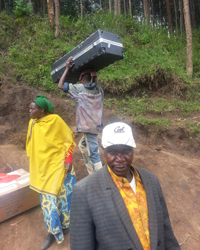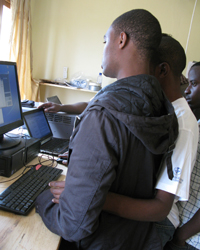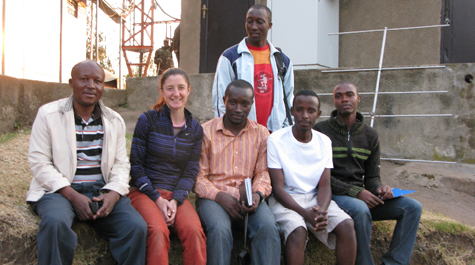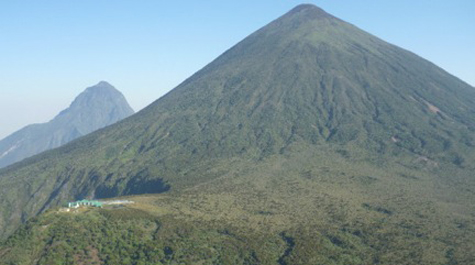Past VIMS student strives to put Africa on climate-change map
For years, scientists have been using computer models to simulate climate change and its effects, but not all areas of the world have the scientific infrastructure needed to gather or monitor the environmental data that inform climate projections and record ecosystem impacts.
William & Mary alumna Dr. Katherine Potter, who did her honors thesis with Professor Rob Hale of the Virginia Institute of Marine Science in 2004, is now working to help fill one of the most glaring holes in the global climate-data framework—the continent of Africa.
Potter, a researcher with the Massachusetts Institute of Technology’s Center for Global Change Science, is the principal investigator for the Rwanda Climate Observatory—an initiative to train future scientists, technicians, and academics in Rwanda to collaborate in the world’s efforts to monitor climate change. Potter’s goal is to empower Rwandans to become a part of climate-change research, and to get Africa on the climate-change grid.
“As climate change is happening, Africans are going to be affected much more than other parts of the world because of their vulnerability to droughts, flooding, rain, and their dependence on agriculture,” explains Potter. “It’s important for them to have information on the direction their climate is headed to help them deal with these imminent changes.”
The observatory project—located on the slopes of a 4,500-meter volcano in northwestern Rwanda called Mt. Karisimbi—is a partnership between the Rwandan Ministry of Education and MIT. Its main purpose is to collect atmospheric observations to help forecast the weather and monitor climatic conditions, and to build scientific, engineering, and educational capacity within the Republic of Rwanda.
Potter is an atmospheric scientist and engineer with an expertise in hardware engineering and use of scientific instrumentation in both the lab and the field. As the station’s lead scientist, Potter’s role is to build the observatory from the ground up and to train local staff in the science and long-term maintenance of the station.
When completed, the observatory will join the Advanced Global Atmospheric Gases Experiment (AGAGE), a worldwide program funded in part by NASA and NOAA that captures climate data. Until now, Africa—a continent that accounts for a fifth of the world’s landmass—has had no long-term, continuous record of air pollution or greenhouse gas emissions.
The project began in 2008 when Rwandan president Paul Kagame approached then MIT president Susan Hockfield to discuss how MIT scientists might help Rwanda build its research, science, and educational capacities. Potter, who was finishing up her Ph.D. at MIT at the time, jumped on the project and became the project’s lead scientist after completing her doctorate in 2011.
Potter became interested in issues affecting the environment at an early age. While completing her undergraduate degree in chemistry at W&M, she wanted to work with scientists who focused on environmental issues, so she came to VIMS to work with Hale on her honors thesis. The pair teamed up to analyze the presence of flame-retardant compounds known as PBDEs in peregrine falcon eggs, as the contents of the eggs are a marker for environmental levels of pollution.
After graduating from W&M, Potter moved to Boston to work in the field of environmental education and to figure out what her next step would be education-wise. While attending an event for Boston-area educators at the Boston Museum of Science, Potter says it was like a light bulb went off when the speakers started discussing atmospheric chemistry.
“It was in that amazing moment that I saw an opportunity to use my chemistry background while also getting to look at environmental issues, and I just knew atmospheric chemistry was the career field for me,” says Potter. After the event, Potter went on to pursue her doctoral education at MIT.
While Rwandans do have access to bachelor’s degree programs in local universities, Potter’s collaboration with the Rwandan Ministry of Education will enable Rwandans to achieve higher levels of education that will allow them to one day manage the observatory on their own.
“We’re currently building a Master’s degree program in climate science because our eventual goal is to pull away,” says Potter. “We hope to reach a point where we finish establishing the observatory and feel comfortable having a Rwandan PI take over.”
Potter estimates the observatory will take a number of years to be fully staffed by Rwandan scientists. Until then, she is enjoying the opportunity to work on a project that is focused on more than instruments and data.
“I’ve always enjoyed working with people,” says Potter. “This project combines my love of science and engineering, while also giving me the opportunity to work with the people of Rwanda. It’s been a very rewarding experience so far.”



